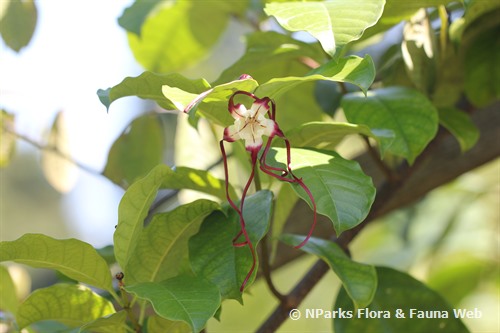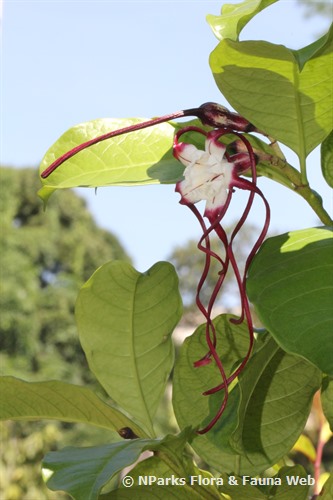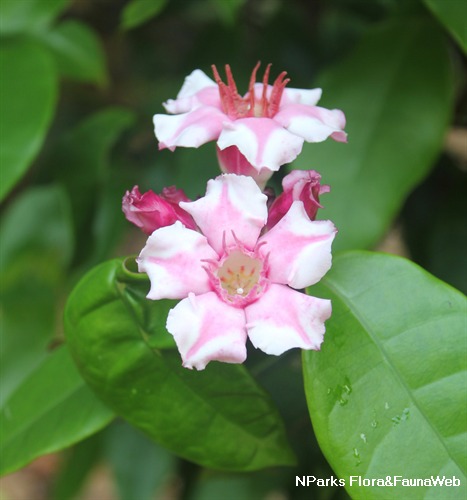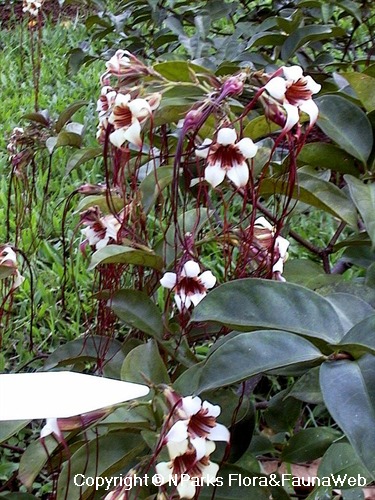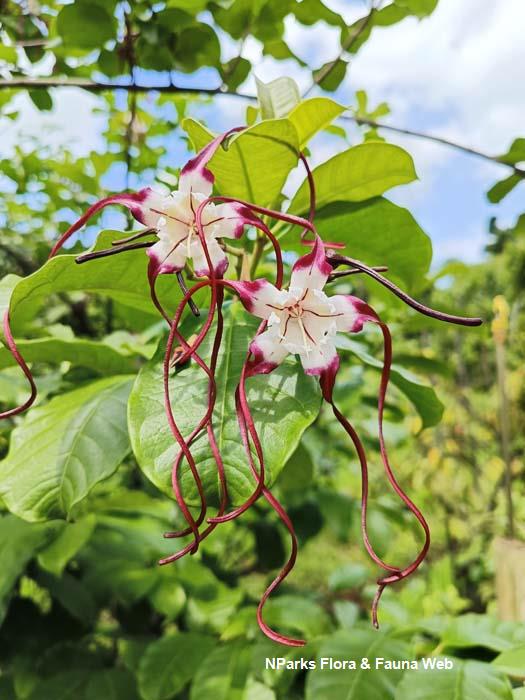
Back
Strophanthus caudatus (L.) Kurz
| Family Name: | Apocynaceae |
| Synonyms: | Strophanthus dichotomus, Strophanthus griffithii, Strophanthus longicaudatus |
| Common Name: | Tanduk-tanduk, Tandok-tandok, Dudur Kijang, 卵萼羊角拗 |
Strophanthus caudatus, also known as Tanduk-tanduk is a trailing shrub or a large climber that grows up to 12 m long. It displays beautiful white star-shaped flowers with long twisting red tendrils coming from the end of each petal. Growing under full sun to semi-shade condition with moderate watering, it is the preferred local food plant for Malayan Crow butterflies (Euploea camaralzeman).
Name
Classifications and Characteristics
| Plant Division | Angiosperms (Flowering Seed Plants) (Dicotyledon) |
|---|---|
| Plant Growth Form | Climber, Shrub |
| Lifespan (in Singapore) | Perennial |
| Mode of Nutrition | Autotrophic |
| Maximum Plant Spread / Crown Width | 12 m |
Biogeography
| Native Distribution | India to Southeastern China, Peninsular Malaysia, Singapore, to New Guinea. |
|---|---|
| Native Habitat | Terrestrial |
| Preferred Climate Zone | Tropical |
| Local Conservation Status | Native to Singapore (Critically Endangered (CR)) |
Description and Ethnobotany
| Growth Form | A trailing shrub to a woody climber that can grow up to 12 m long. |
|---|---|
| Foliage | Its opposite, shortly stalked leaves have thickly papery to leathery leaf blades that are elliptic-oblong or drop-shaped and measures 4.2 - 17.5 cm long, 1.5–7.5 cm across, with 6-12 pairs of veins. The leaf blade has acuminate to rounded leaf tip, and cuneate base. |
| Stems | Its stems are about 2 cm in diameter. Its bark is dark and dotted with many lenticels. |
| Flowers | Flowers grow in axillary, stalked, few-flowered clusters. Its calyx lobes are egg-shaped, and 0.6 cm wide, with long narrow tails. Its corolla-tube is white and 1.3 cm long with purplish-red lobes with white and yellow in the centre. |
| Fruit | Its fruit are large and woody, green, oblong-shaped, and about 10-30 cm long, 1.9-4.8 cm in diameter. It has small grain-like seeds. |
| Habitat | It grows in lowland forest, sometimes in swampy forest. |
| Associated Fauna | It is the preferred local food plant for caterpillars of the butterfly Malayan Crow (Euploea camaralzeman). |
| Etymology | The genus epithet Strophanthus means twisted flowers, while the species epithet caudatus means tailed. Both are with reference to the tailed twisted flowers of this species. |
Landscaping Features
| Landscaping | This species has ornamental flowers of white star-shaped with long twisting red tendrils coming from the end of each petal, it is suitable for growing where there is strong and sturdy support for plant to climb. |
|---|---|
| Desirable Plant Features | Ornamental Flowers |
| Landscape Uses | Parks & Gardens, Trellis / Arbour / Pergola |
| Thematic Landscaping | Butterfly Garden |
Fauna, Pollination and Dispersal
| Fauna Pollination Dispersal Associated Fauna | Butterfly Host Plant |
|---|---|
| Pollination Method(s) | Biotic (Fauna) (Insects (Butterfly, Moth)) |
Plant Care and Propagation
| Light Preference | Full Sun, Semi-Shade |
|---|---|
| Water Preference | Moderate Water |
| Plant Growth Rate | Fast to Moderate |
| Rootzone Tolerance | Fertile Loamy Soils, Well-Drained Soils |
Foliar
| Foliage Retention | Evergreen |
|---|---|
| Mature Foliage Colour(s) | Green |
| Mature Foliage Texture(s) | Glossy / Shiny, Leathery |
| Prominent Young Flush Colour(s) | Green |
| Foliar Type | Simple / Unifoliate |
| Foliar Arrangement Along Stem | Opposite |
| Foliar Attachment to Stem | Petiolate |
| Foliar Shape(s) | |
| Foliar Venation | Pinnate / Net |
| Foliar Margin | Entire - Wavy / Undulate |
| Foliar Apex - Tip | Acuminate |
| Foliar Base | Cuneate |
Non - Foliar and Storage
| Mature Bark Texture | Lenticellate |
|---|---|
| Stem Type & Modification | Woody |
| Root Type | Underground |
Floral (Angiosperm)
| Flower Colour(s) | Red, White |
|---|---|
| Flower Texture(s) | Smooth |
| Flower Grouping | Cluster / Inflorescence |
| Flower Location | Axillary |
| Flower Symmetry | Radial |
| Individual Flower Shape | Funnelform / Funnel-shaped, Stellate / Star-shaped |
Fruit, Seed and Spore
| Mature Fruit Colour(s) | Green |
|---|
References
| References | <1> Middleton, D.J. & Rodda, M. (2019). Apocynaceae. Flora of Singapore. vol.13:520-523. |
|---|
Image Repository
Others
| Master ID | 33715 |
|---|---|
| Species ID | 8129 |
| Flora Disclaimer | The information in this website has been compiled from reliable sources, such as reference works on medicinal plants. It is not a substitute for medical advice or treatment and NParks does not purport to provide any medical advice. Readers should always consult his/her physician before using or consuming a plant for medicinal purposes. |


